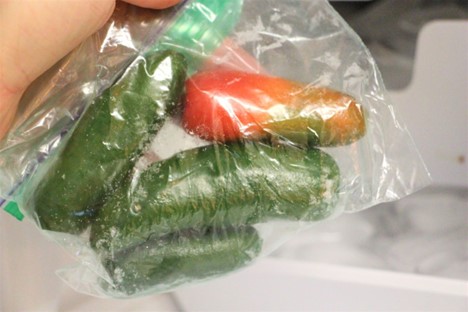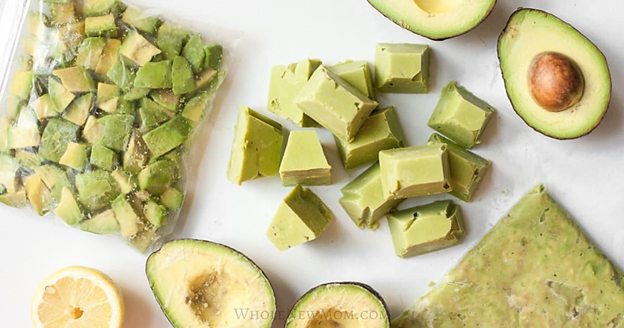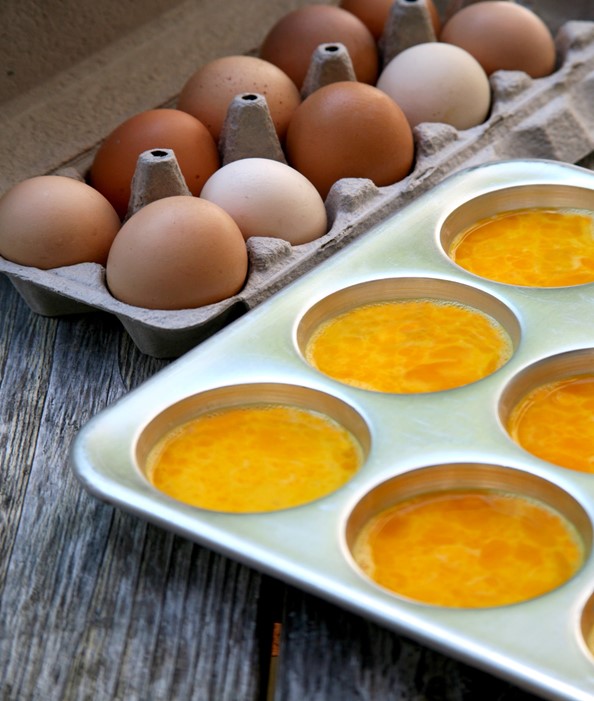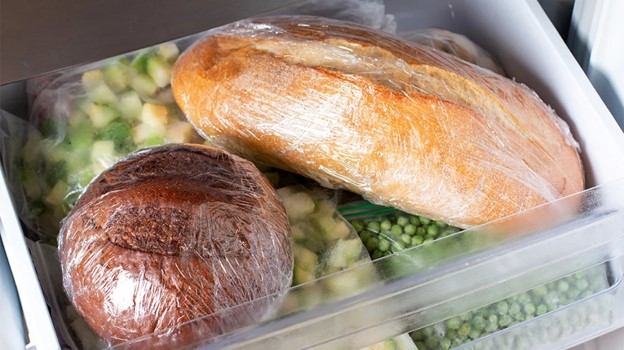Did You Know You Can Freeze These Things?
Food researcher and editor, plus pastry chef, Rebecca Eisenberg, says the freezer is actually a kitchen’s secret weapon. Its perfect icy cold environment does a superb job of extending the shelf life of foods and preventing spoilage, rancidity, the slimes, or staleness. And extending shelf life translates to saving money.

Rebecca says it all boils down to knowing how to freeze properly and how to use them once they defrost. She shares quite a list of things that freeze well, some of which you may not have thought of. For instance, look at produce:
Bananas are a good example. There’s only so much banana bread you can make at a time. When they go on sale, peel them, wrap them well and freeze them in plastic freezer bags.
And jalapeños (and other hot peppers) also freeze well and stay flavor-vibrant for up to 9 months. Freezing them not only extends their shelf life, it also provides an efficient way to prep them. Still-frozen peppers grate much easier on a microplane than fresh peppers. Because the seeds don’t through the microplane, there’s no deseeding needed. AND, because the peppers are frozen, you’re less likely to get the spicy capsaicin juices all over your hands (though you still should wear gloves while handling them). Try this technique and see what a game-changer it is.

Then there’s broccoli stalks. Buy fresh and freeze the stalks along with the florets. Stalks are packed full of flavor and are perfect for making creamy broccoli soup. They’ll freeze for 6 to 8 months.
Celery can keep frozen for a year if you blanch it first. Otherwise, it’ll stay flavorful for up to 2 months. So stop the cycle of celery waste by breaking any leftover celery into individual stalks, arranging them on a sheet pan, and sticking them in the freezer. Then a transfer the frozen stalks to an airtight bag, press out any air and seal. This celery won’t defrost into crunchy sticks, but will still be find for cooking down in soups and stews.
If you can’t use fresh herbs fast enough, freeze them. They’ll stay tasty for 6 to 9 months. Freeze them in ice cube trays submerged in olive oil or melted butter. Whole leaves freeze well, but for bigger or heartier herbs like basil and rosemary, it’s better to mince or chop them first.

When ready to use, just toss the entire cube into a skillet or pot with your food and let the oil melt into the dish. This method only works with recipes that can handle the additional oil, like pasta and a lot of sauces. Know though, that you can’t defrost the herbs and mince or dice them, or use them as a garnish.
And have you discovered the amazing taste of frozen seedless grapes? Also, frozen seeded grapes (like the Concord we grow) are fantastic in smoothies. Grapes stay good frozen for 12 months.
Did you know you can freeze avocados? Their freezer life is 4 to 6 months. Dice or slice peeled and pitted avocados, then toss them in lemon juice and freeze on a silicone- or parchment-lined sheet pan. Once frozen, transfer them to a zippered freezer bag, press out any air, and freeze. You can add these frozen avocado pieces directly to smoothies without defrosting first.
You can also freeze mashed or pureed avocado (with a bit of lemon juice) in an ice cube tray or container. (I had no idea!)

And then there are plenty of “pantry staple” ingredients that can go in the freezer, either to extend their shelf life or as a way to store extras until you’re ready to use them. For instance:
Butter freezes well (up to 9 months) and so do Parmesan cheese rinds (indefinitely). Parmesan rinds are entirely natural and edible, and not, as many people believe, made of wax. Stash these in the freezer and drop one or two into soups, stews, broths, and sauces — basically anything that cooks low and slow. The rinds add a nice umami flavor and they get super soft and melty, making them a real treat for whoever finds them in their bowl.
It’s always smart to freeze your flours right after you bring them home from the store. This will kill any weevil you might inherit as well as extend their shelf life. Most folks don’t have a lot of random freezer space to dedicate to flours, but if you can freeze them for even a few days, you’ll be glad you did. Longterm, flours freeze for 6 months before quality is lost. (Caution: just be sure they’re stored in airtight containers so they don’t absorb any funky freezer odors.)

Yeast’s freezer life, unopened, is a year or two. Once opened, official word is yeast will stay good in the freezer for 6 months, but Rebecca’s experience is that both instant and active dry yeast can stay good in the freezer for 2+ years. (Alice: that’s my experience also.)
When frozen, this living organism goes dormant until you’re ready to use it. You can extend its shelf life up to a year or more just by storing it in the freezer instead of in the back of a drawer or cupboard. And there’s no need to defrost or let it come to room temp first, you can use instant or active dry yeast right out of the freezer.
Egg whites freeze beautifully for up to a year. Defrost in the fridge and use them for egg white omelets, whip them up to leaven sponge cakes, and you can even use them to make crispy meringues and pavlovas.
You can also freeze egg yolks and whole eggs. Their texture is a little odd when defrosted, so most professional bakers generally don’t do this. But if you do want to freeze the entire egg, beat them first so that the egg and yolk freeze together then freeze them in a muffin pan. Once frozen, store them in a zippered plastic freezer bag.

Tomato paste freezes for 3 to 6 months. And YAY for this, because when you need a mere tablespoon for a recipe, now you know what to do with the rest of the can. Plop premeasured portions into an ice cube tray, then pop frozen sauce out of the tray and stash it in a bag or airtight container for future use.
And tomato sauce or marinara freezes well and defrosts quickly. Related to marinara sauce is pesto. It freezes beautifully for up to 6 months.
You probably know you can also freeze gravy (for up to 6 months), pre-cooked meatballs (up to 4 months), pizza dough (up to 3 months), pulled pork (up to 3 months), bread goods (up to 3 months if packed air-tight), and soups (up to 3 months).

Lastly, everyone knows to freeze stocks, but don’t forget to freeze soup bases, too. Pop it in a resealable baggie, lay it flat on a sheet pan and freeze it. Do this for several bases and eventually you’ll have a whole library of soup bases lined up in your freezer. Just add some fresh herbs or toppings to a base and you’ll quickly forget you’re eating leftovers!

Rebecca says it all boils down to knowing how to freeze properly and how to use them once they defrost. She shares quite a list of things that freeze well, some of which you may not have thought of. For instance, look at produce:
Bananas are a good example. There’s only so much banana bread you can make at a time. When they go on sale, peel them, wrap them well and freeze them in plastic freezer bags.
And jalapeños (and other hot peppers) also freeze well and stay flavor-vibrant for up to 9 months. Freezing them not only extends their shelf life, it also provides an efficient way to prep them. Still-frozen peppers grate much easier on a microplane than fresh peppers. Because the seeds don’t through the microplane, there’s no deseeding needed. AND, because the peppers are frozen, you’re less likely to get the spicy capsaicin juices all over your hands (though you still should wear gloves while handling them). Try this technique and see what a game-changer it is.

Then there’s broccoli stalks. Buy fresh and freeze the stalks along with the florets. Stalks are packed full of flavor and are perfect for making creamy broccoli soup. They’ll freeze for 6 to 8 months.
Celery can keep frozen for a year if you blanch it first. Otherwise, it’ll stay flavorful for up to 2 months. So stop the cycle of celery waste by breaking any leftover celery into individual stalks, arranging them on a sheet pan, and sticking them in the freezer. Then a transfer the frozen stalks to an airtight bag, press out any air and seal. This celery won’t defrost into crunchy sticks, but will still be find for cooking down in soups and stews.
If you can’t use fresh herbs fast enough, freeze them. They’ll stay tasty for 6 to 9 months. Freeze them in ice cube trays submerged in olive oil or melted butter. Whole leaves freeze well, but for bigger or heartier herbs like basil and rosemary, it’s better to mince or chop them first.

When ready to use, just toss the entire cube into a skillet or pot with your food and let the oil melt into the dish. This method only works with recipes that can handle the additional oil, like pasta and a lot of sauces. Know though, that you can’t defrost the herbs and mince or dice them, or use them as a garnish.
And have you discovered the amazing taste of frozen seedless grapes? Also, frozen seeded grapes (like the Concord we grow) are fantastic in smoothies. Grapes stay good frozen for 12 months.
Did you know you can freeze avocados? Their freezer life is 4 to 6 months. Dice or slice peeled and pitted avocados, then toss them in lemon juice and freeze on a silicone- or parchment-lined sheet pan. Once frozen, transfer them to a zippered freezer bag, press out any air, and freeze. You can add these frozen avocado pieces directly to smoothies without defrosting first.
You can also freeze mashed or pureed avocado (with a bit of lemon juice) in an ice cube tray or container. (I had no idea!)

And then there are plenty of “pantry staple” ingredients that can go in the freezer, either to extend their shelf life or as a way to store extras until you’re ready to use them. For instance:
Butter freezes well (up to 9 months) and so do Parmesan cheese rinds (indefinitely). Parmesan rinds are entirely natural and edible, and not, as many people believe, made of wax. Stash these in the freezer and drop one or two into soups, stews, broths, and sauces — basically anything that cooks low and slow. The rinds add a nice umami flavor and they get super soft and melty, making them a real treat for whoever finds them in their bowl.
It’s always smart to freeze your flours right after you bring them home from the store. This will kill any weevil you might inherit as well as extend their shelf life. Most folks don’t have a lot of random freezer space to dedicate to flours, but if you can freeze them for even a few days, you’ll be glad you did. Longterm, flours freeze for 6 months before quality is lost. (Caution: just be sure they’re stored in airtight containers so they don’t absorb any funky freezer odors.)

Yeast’s freezer life, unopened, is a year or two. Once opened, official word is yeast will stay good in the freezer for 6 months, but Rebecca’s experience is that both instant and active dry yeast can stay good in the freezer for 2+ years. (Alice: that’s my experience also.)
When frozen, this living organism goes dormant until you’re ready to use it. You can extend its shelf life up to a year or more just by storing it in the freezer instead of in the back of a drawer or cupboard. And there’s no need to defrost or let it come to room temp first, you can use instant or active dry yeast right out of the freezer.
Egg whites freeze beautifully for up to a year. Defrost in the fridge and use them for egg white omelets, whip them up to leaven sponge cakes, and you can even use them to make crispy meringues and pavlovas.
You can also freeze egg yolks and whole eggs. Their texture is a little odd when defrosted, so most professional bakers generally don’t do this. But if you do want to freeze the entire egg, beat them first so that the egg and yolk freeze together then freeze them in a muffin pan. Once frozen, store them in a zippered plastic freezer bag.

Tomato paste freezes for 3 to 6 months. And YAY for this, because when you need a mere tablespoon for a recipe, now you know what to do with the rest of the can. Plop premeasured portions into an ice cube tray, then pop frozen sauce out of the tray and stash it in a bag or airtight container for future use.
And tomato sauce or marinara freezes well and defrosts quickly. Related to marinara sauce is pesto. It freezes beautifully for up to 6 months.
You probably know you can also freeze gravy (for up to 6 months), pre-cooked meatballs (up to 4 months), pizza dough (up to 3 months), pulled pork (up to 3 months), bread goods (up to 3 months if packed air-tight), and soups (up to 3 months).

Lastly, everyone knows to freeze stocks, but don’t forget to freeze soup bases, too. Pop it in a resealable baggie, lay it flat on a sheet pan and freeze it. Do this for several bases and eventually you’ll have a whole library of soup bases lined up in your freezer. Just add some fresh herbs or toppings to a base and you’ll quickly forget you’re eating leftovers!
 Alice Osborne
Alice Osborne
Weekly Newsletter Contributor since 2006
Email the author! alice@dvo.com
